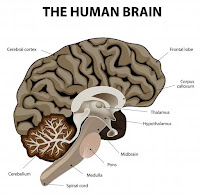A tiny bit of fear shields us from threat, however a lot of can bring about genuine mental illness and, now and again, psychological wellness issues. New research reveals the brain circuit required in handling dread or fear, which could in the long run prompt to new treatment choices for individuals with psychological well-being scatters.
 |
| Brain emotion center |
From a developmental viewpoint, dread and nervousness are very valuable. These profoundly instilled feelings used to shield our precursors from predators, and in our circumstances the “fight or-flight” reaction is still a solid response to risky circumstances.
At the point when dread is proportionate to the peril a man is in, it is a typical, versatile reaction. Notwithstanding, a few of us have overstated responses to unpleasant circumstances.
As the National Institute of Mental Health clarifies, when the dread reaction is unbalanced or endures a considerable measure longer than what is regularly anticipated from the circumstance – to a point where it meddles with an individual’s prosperity and day by day working – it is classed as a nervousness issue.
Uneasiness issue incorporate an extensive variety of conditions that supposedly influence 18 percent of the grown-up populace in the United States.
Since we pass a portion of the brain’s design to our kindred warm blooded creatures and we have a comparable reaction to dread, concentrate creature models has given researchers vital bits of knowledge into the neuroscientific reason for dread preparing.
Up until now, creature ponders have demonstrated that the amygdala is a key player in dread preparing, and that the hippocampus additionally assumes a huge part in shaping recollections of passionate occasions.
Be that as it may, specialists from the University of California-Irvine (UCI) trust that this group of research has not adequately explored how the two areas connect within the sight of a frightful jolt.
This is the reason the researchers – drove by Dr. Jack Lin, a teacher of neurology at UCI – set out to look at the neural pathways required in dread and uneasiness preparing in people.
The discoveries were distributed in the diary Nature Communications.
Examining the brain’s fear response in humans
Specialists surgically embedded anodes into the amygdala and hippocampus of nine members, who were made a request to watch scenes from blood and gore flicks.
The amygdala is an almond-molded district in the cerebrum, arranged appropriate alongside the hypothalamus, which goes about as the principle community for preparing feelings, enthusiastic conduct, and inspiration.
The amygdala, together with the hypothalamus and the hippocampus, shape the cerebrum’s limbic framework, which manages memory and feelings.
The research members had a type of pharmaceutical safe epilepsy. The anode situation was done as a component of the clinical assessment of their seizure movement, and the writers promise the perusers that the terminals were embedded exclusively as indicated by the clinical needs of the patients.
Lin and group recorded the members’ neural action. As Jie Zheng, the review’s first creator clarifies, “profound mind cathodes catch neurons terminating millisecond by millisecond, uncovering progressively how the brain goes to frightful boosts.”
The scientists found that the amygdala and the hippocampus specifically trade signals when an individual perceives enthusiastic boosts.
In the first place creator Zheng clarifies the discoveries in more detail:
“Neurons in the amygdala terminated 120 milliseconds sooner than the hippocampus,” the creator says. “It is really amazing that we can gauge the brain progression with such exactness. Advance, the movement design between the two mind areas are controlled by the feeling of the film; a unidirectional stream of data from the amygdala to the hippocampus just happened when individuals were viewing frightful motion picture cuts yet not while viewing serene scenes.”
Lead creator Lin says that the research gives “coordinate confirmation that the amygdala first concentrates enthusiastic importance and afterward sends this data to the hippocampus to be prepared as a memory.”
Lin additionally clarifies what this implies for treatment alternatives and how their review could affect the advancement of new treatments for psychiatric issue.
According to Lin:
“This is the first study in humans to delineate the mechanism by which our brain processes fear at the circuitry level. This has huge implications for treating neuropsychiatric disorders. For example, current drugs available to treat anxiety disorder bind to large areas of the brain, leading to unwanted side effects. Our hope is that we will one day be able to target and manipulate the precise amygdala-hippocampal circuit involved in processing negative emotions while preserving positive ones.”
Dr. Jack Lin
Source:







